For our annual manul photo tour, we visited eastern Mongolia for over three weeks, leading three back-to-back manul photo tours. For this trip report, we are highlighting the events of our first tour, where we saw two different Pallas’s cat families, mostly spending time with a mom we named Nutella, and her three four week old kittens. Read the rest of our manul of Mongolia photo tour 2025 trip report to hear about all the details.
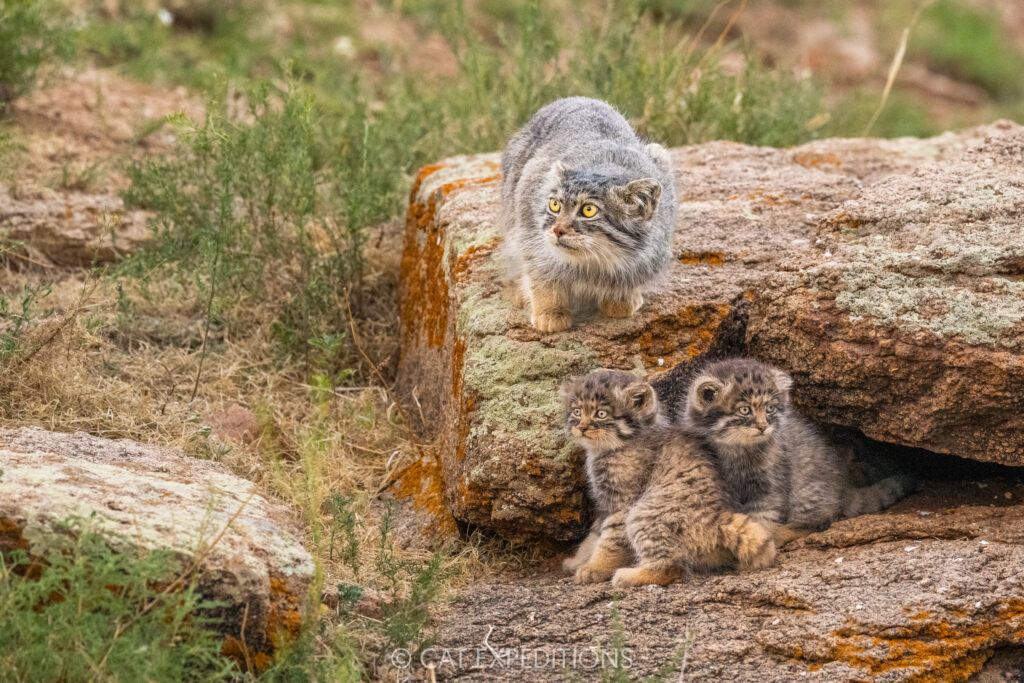
Highlights of the first 2025 Manul of Mongolia Photo Tour
Manul: We saw two different families of manul, each with three kittens. One female, Nutella, quickly became our favorite. Her kittens were quite small, just about four weeks old. Our closest sighting was at nineteen meters, and on average the cats were about twenty five meters away from us. We saw manul on all days we spent in the field.
Manul kittens growing up: We were able to witness the first few steps of the kittens emerging from the den. In the beginning the kittens were quite shy, being afraid of songbirds around the den. As the week progressed we were able to watch them gain confidence and even start to play outside of the den. It was super cool seeing this progression and witnessing the kittens growing up.
Manul behavior: We were able to witness some really special Pallas’s cat behavior. Play behavior is a common thing we get to see from the kittens, but it is nonetheless very special every time it happens. Incredibly unique behaviors we got to witness during this week were the kittens feeding on a Mongolian Five-toed Jerboa (Allactaga sibirica), a nocturnal species, which is quite unusual. We also saw Nutella nursing her three kittens, a very special behavior we don’t get to see very often.
Detailed first Manul of Mongila Trip Summary 2025
Day 1: Everyone arrived in Ulaanbaatar smoothly and right on time — a solid start to the adventure. We kicked things off with an early welcome dinner, which was the perfect chance to break the ice and start getting to know one another. There was a great energy around the table — a mix of excitement and a touch of jet lag — and after some good food and conversation, we all headed to bed for some much-needed rest.
Day 2: We hit the road early, leaving UB at 6am sharp. After a long but scenic drive and a lunch stop where we shared our welcome presentation — laying out the plan for the week and how we’d be photographing manuls — we pulled into camp around 3:30pm. After settling in and a quick regroup, we were back out the door by 4:30, heading straight to our first manul den.
On the way, we spotted a Corsac fox — a brief but thrilling sighting to kick things off. Once in the blind, the long wait began. Hours passed as we watched for any signs of movement, and while the den stayed quiet, we could tell there was activity inside. Every so often, we’d catch the tiniest glimpse of a face — clearly these kittens were very young, their eyes still a vivid, baby blue.
Just as the sun began to sink low on the horizon, bathing the steppe in soft pink light, one bold little kitten finally popped its head out far enough for us to really see him. It was magical — that tiny face glowing in the evening light. We got a few more of those quick little peeks, like they were playing a game of kitten hide-and-seek. Still no sign of mom — we guessed she might actually be inside with them. From what we could tell, there were likely two or three kittens tucked in the den. A quiet evening, but full of promise.

Day 3: We were up by 3:30am, groggy but buzzing with anticipation, and rolled out of Manul Camp by 4. Our destination: the same den, with high hopes that the kittens might be a bit more active this time. And sure enough, after some patient waiting, tiny heads began to poke out — a bit earlier than the day before, but still keeping us on our toes.
This time, they were snacking on a Mongolian Five-toed Jerboa (Allactaga sibirica), and it was wild to watch. One of the kittens even dragged it right to the edge of the cavity, giving us a front-row seat to the action. Seeing that little face munching away was something else.
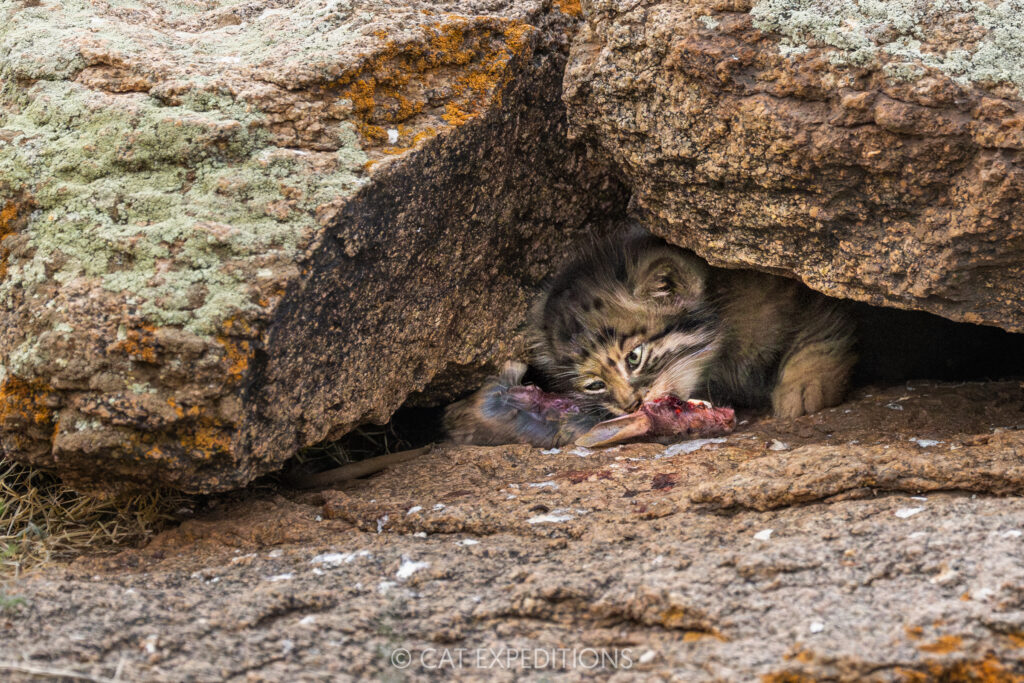
Mom was nearby for a brief moment, just a quick flash of her before she disappeared again, seemingly resting somewhere about 30 meters away, hidden from view. The three kittens kept peeking out, inching forward with the slowest, most cautious steps — one paw at a time. One bold little explorer made it halfway out, but the sudden flutter of a tiny songbird was enough to send it scrambling back into the den like a shot.
By 8:30am, the sun was already blazing and the light had gone harsh, so we packed up and made our way back to camp — tired, sun-soaked, and completely thrilled.
In the afternoon, we headed out to the blind at 5pm, trying to beat the heat and settle in before anything started moving. Turns out, we weren’t the only ones eager — the kittens began poking their heads out even earlier than we expected. One of them got almost all the way out, testing the edge of the den, but they were still hesitant, not quite ready to venture fully into the open.
Then we spotted the mother — and that changed everything. She was slowly making her way down the hill, chattering and flicking her tail like a rattlesnake, completely bothered by the mob of birds harassing her along the way. It was an incredible sight, her descent both commanding and deliberate.
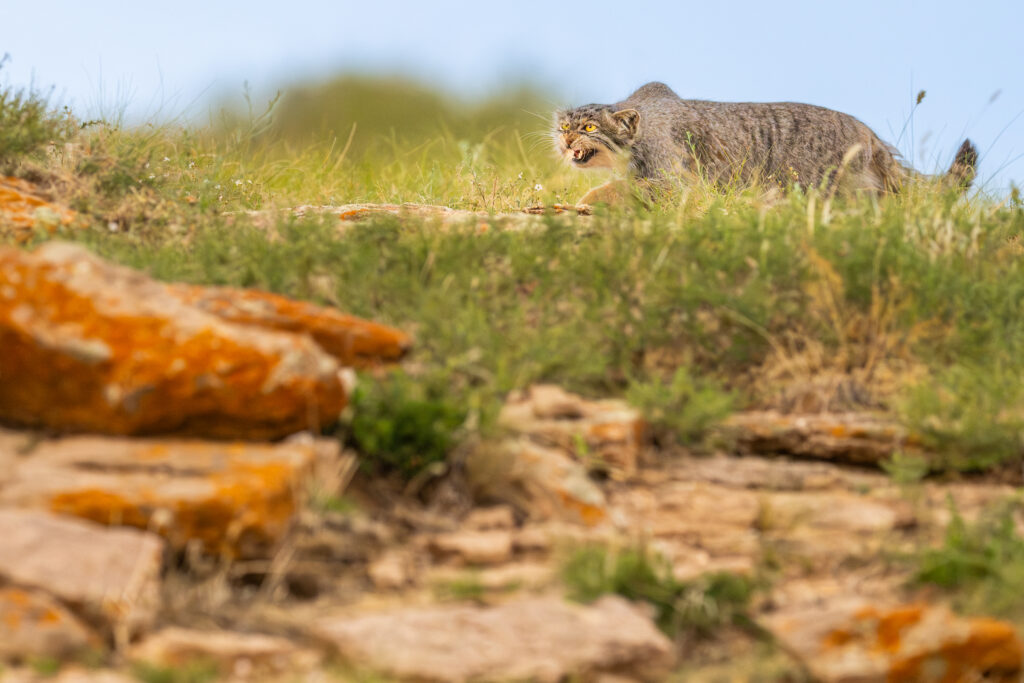
As soon as she reached the den and peeked inside, it was like she gave the all-clear — the kittens poured out, instantly more confident. She groomed them, they tumbled over each other, and together they wandered around and even climbed on top of the den, playful and full of life.
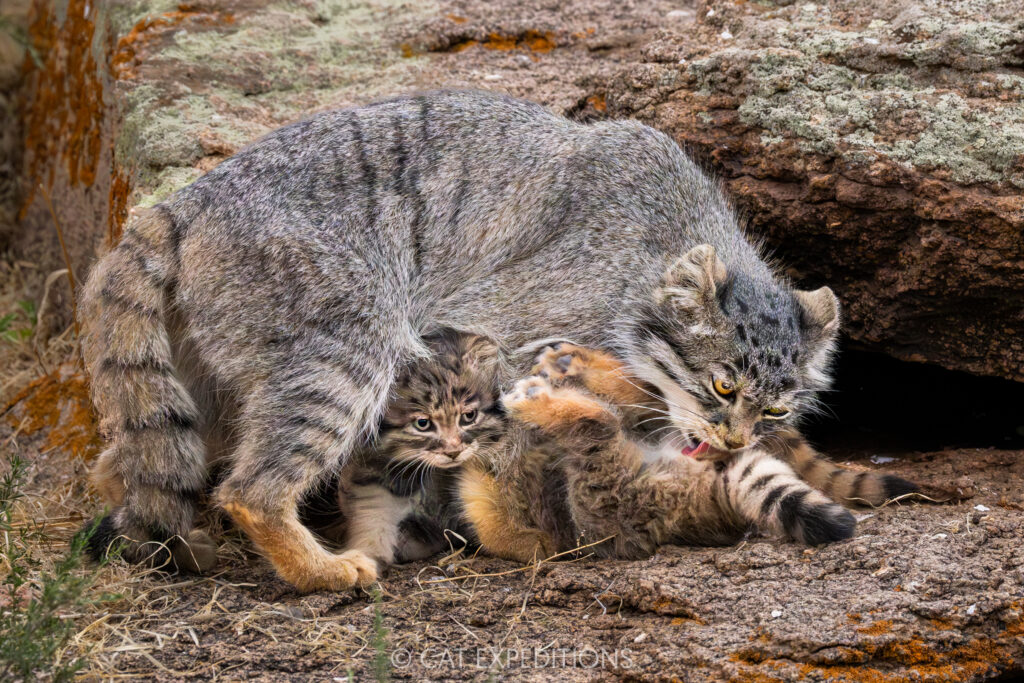
And then, to top it all off, she lay down and began nursing them — and the whole time, she stared directly at us. It felt like she was acknowledging us, letting us witness something deeply personal. We stayed until the last light faded around 8:45, completely in awe. What a night.

Day 4: Another 4am departure — we were definitely getting into the rhythm now. We made it to the blind and the kittens didn’t keep us waiting. They popped out almost right away, clearly braver than the day before. It was like they’d built up a little confidence overnight. They started exploring the far side of the den, climbing and playing before eventually disappearing behind it, out of sight. We had a strong feeling mom was nearby, keeping an eye on things even if we couldn’t see her.

By 7:30, we wrapped up the session, happy with what we’d seen. Back at camp, the afternoon was filled with editing sessions — always a favorite part of the day. It was so fun seeing everyone’s shots and reliving the morning through each other’s images. The talent in the group really showed.
We headed out again at 5pm. It was hot — the kind of heat that makes everything feel a little slower — but the wind started to pick up, offering a bit of relief. When we arrived at the den, we realized mom had moved the kittens, but not far — just about 15 meters from the original den. As we were setting up the blind, we caught a glimpse of one of the kittens poking out. It was a promising start.
But just as we settled in, the skies had other plans. A big storm rolled in fast — rain and lightning cracked over the landscape — and we had to abandon the blind and take cover in the car. The lightning kept going, so we ultimately called it for the night. Not what we’d hoped for, but there was a silver lining: early bedtime and a chance to recharge for the next adventure.
Day 5: This morning brought a bit of a mystery — the kittens weren’t in their usual den. Nutella (yes, we had officially named the mom!) had clearly moved them overnight, a common behavior for pallas’s cats. It took some time, but we found them in their new den around the corner from their original spot. The new den was much larger and more complex — full of big boulders and plenty of nooks and crannies to hide in.
We settled in and waited… and waited. Eventually, we started getting little flashes of movement — the occasional head popping out for a quick look. They weren’t keen on fully emerging, but we knew they were there. The steady stream of bird alarm calls confirmed it — something was going on behind those rocks.
During the middle of the day, our local guides found another den. Since this was our halfway point of the tour, we decided to give it a try.
This den was perched high up on a big hill, set along a steep slope, and the whole team handled the climb like pros — no one rolled down! The view from up there was stunning — the steppe stretching out below us, endless and golden.
After a couple of hours of quiet watching, we were rewarded: the tiniest kittens began peeking out, just little fuzzy faces blinking at the world. We were pretty sure we saw three in total, though none came fully out. Still, the soft evening light gave us some beautiful views.
As the sun dropped, the sky lit up in brilliant orange, reflecting off a patch of standing water in the distance. We even watched for the elusive green flash — no luck this time, but it was the perfect end to a magical day.

Day 6: We were back with Nutella again today! Baska, our den-finding wizard, spotted her at the same den as before, so we set up quietly and got into position, hopeful for another peek into her world.
After about an hour of waiting, we saw her — just the top of her head and those signature eyes peeking out from behind the rocks (we never get tired of that peek!). Soon after, she slipped away, most likely heading out on a hunt, though she disappeared so smoothly we didn’t catch where she went.
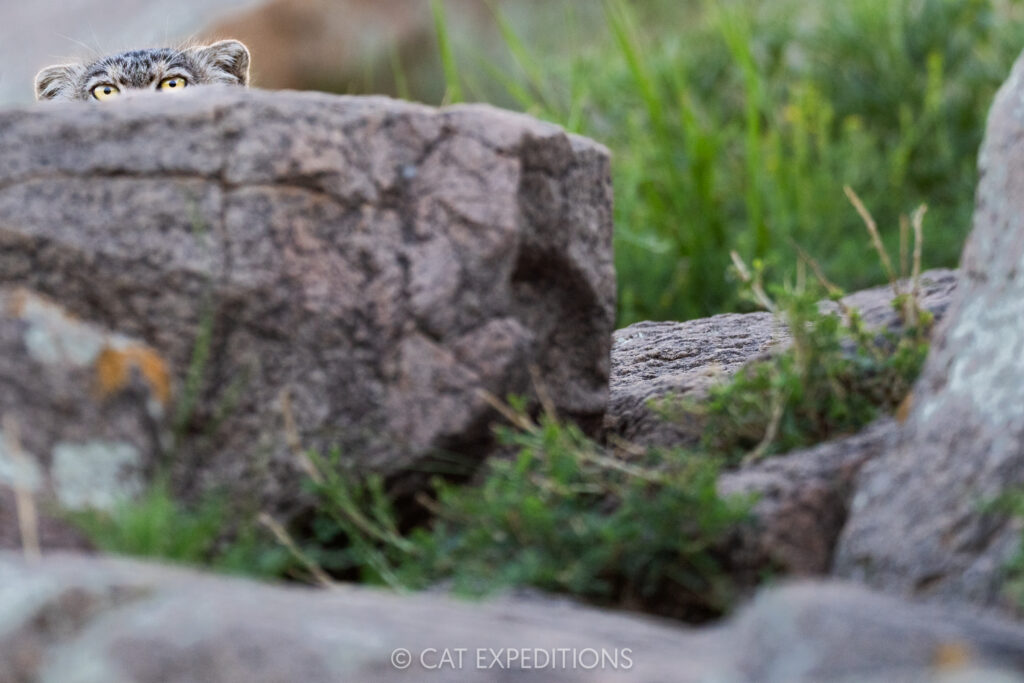
As the sun began to dip and the light turned golden, the kittens started making their appearances — just brief ones at first, tiny faces poking out cautiously from the den. Then, like clockwork, Nutella returned, and there was a quiet little family reunion. We got a short but gorgeous glimpse of her with one of the kittens before she gathered them up and gracefully led them over the rocks.
We followed them with our eyes as they climbed — a fleeting moment of togetherness, beautifully lit and unforgettable. Then they vanished over the ridge, hidden once again. A little while later, our local guide spotted Nutella in the distance, several hundred meters from the den, actively hunting — and she actually saw her make two vole kills!
We took that moment as our cue to pack up and quietly head out, happy to minimize our impact and leave the wild family in peace.

Day 7: This morning, the group split up. Two of our guests headed to a fox blind just outside of camp to try their luck, while the rest of us returned to the search for Nutella. Unfortunately, it looked like she had moved again — no sign of her or the kittens at the previous den. After some quick scouting, we decided to race over to the other den in hopes of catching a glimpse of the younger litter.
We were rewarded with a couple of sweet moments: two of the tiniest kittens peeked out a few times, giving us just enough to smile about before ducking back inside. They never fully emerged, but it was great to confirm they were still there and doing well.
Meanwhile, Torie and Simon had an incredible morning with the foxes. After spotting a family of five a few hundred meters from the den, they went on foot and captured some lovely shots of the foxes playing in the open. Back at the blind, the female fox came within ten feet — hunting right in front of them in that dreamy morning light, flushing grasshoppers and chasing down voles. As if that wasn’t enough, a hoopoe landed right on the blind window, giving them an incredible close-up.
Later in the morning, we all met up with our local guide, who brought us down to the riverbed to see two Eurasian eagle owls with their chicks. The chicks were still tiny — one was just a ball of white fluff! We also got our first look at a Steppe Eagle — a real highlight for the bird lovers in the group.
It turned out to be one of the hottest days of the trip, soaring to 95°F (35°C), so the afternoon was all about rest and recovery.
Thankfully, a bit of cloud cover rolled in as we headed back out in the evening. We returned to Nutella’s den, hopeful for another good look. But just after setting up the blind, we had to retreat — a fast-moving thunderstorm was rolling in. We waited it out for about twenty minutes (Haribo made the delay much more tolerable!), and as soon as it passed, we slipped back into position
After about an hour of quiet, Nutella appeared — regal and calm, stretched out across the top rocks, surveying her domain. We repositioned one of our guests in the blind so she could get a clear view too. Nutella moved around the den for a while, vanishing into and reappearing from the rocks like a ghost. The kittens were active, too, though mostly hidden in the boulders.
Eventually, Nutella settled again, and one by one, the kittens joined her. We watched some sweet interactions — a gentle head nuzzle here, a little bum lick there (classic mom behavior, encouraging the kittens to poop!). It was peaceful, loving, and full of the quiet kind of beauty that stays with you.

We watched the family until 8:40pm, when the light finally faded. It was the perfect ending to the trip — intimate, calm, and full of connection. We all left feeling incredibly grateful for such a tender, final evening with our new favorite manul mom, Nutella, and her little ones.
Day 8: We woke to the sound of heavy rain pattering on our tents — the kind of steady, soaking rain that turns the landscape into a muddy maze. It was time to pack up and say goodbye to camp, our home for the past unforgettable week.
The drive back to Ulaanbaatar was slow and slippery, the roads thick with mud. Along the way, we managed one last wildlife moment — a brief but beautiful glimpse of a Saker Falcon perched in one of the nest boxes placed by researchers, a fitting farewell from the steppe.
Though the weather was dreary, spirits were high. We rolled into UB full of stories, photos, and memories — hearts full from an extraordinary adventure with Nutella, her kittens, and all the wild wonder the manuls of Mongolia had to offer.
Manul of Mongolia Photo Tour 2025 Species List – Trip 1
Mammals
| Manul | Otocolobus manul |
| Corsac Fox | Vulpes corsac |
| Mongolian Gerbil | Meriones unguiculatus |
| Brandt’s Vole | Lasiopodomys brandtiie |
Birds
| Ruddy Shelduck | Tadorna ferruginea |
| Common Shelduck | Tadorna tadorna |
| Demoiselle Crane | Anthropoides virgo |
| Cinereous Vulture | Aegypius monachus |
| Steppe Eagle | Aquila nipalensis |
| Black Kite | Milvas migrans |
| Upland Buzzard | Buteo hemilasius |
| Eurasian Eagle-Owl | Bubo bubo |
| Saker Falcon | Falco cherrug |
| Common Swift | Apus apus |
| Pacific Swift | Apus pacificus |
| Eurasian Hoopoe | Upupa epops |
| Daurian Jackdaw | Corvus dauuircus |
| Common Raven | Corvus corax |
| Northern Wheatear | Oenanthe oenanthe |
| Isabelline Wheatear | Oenanthe isabellina |
| Horned Lark | Eremophila alpestris |
| Mongolian Lark | Melanocorypha mongolica |
| House Sparrow | Passer domesticus |
| Eurasian Tree Sparrow | Passer montanus |
| Rock Sparrow | Petronia petronia |
